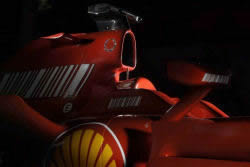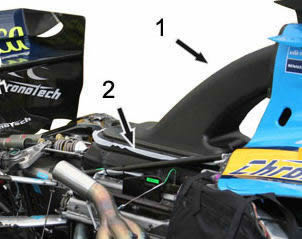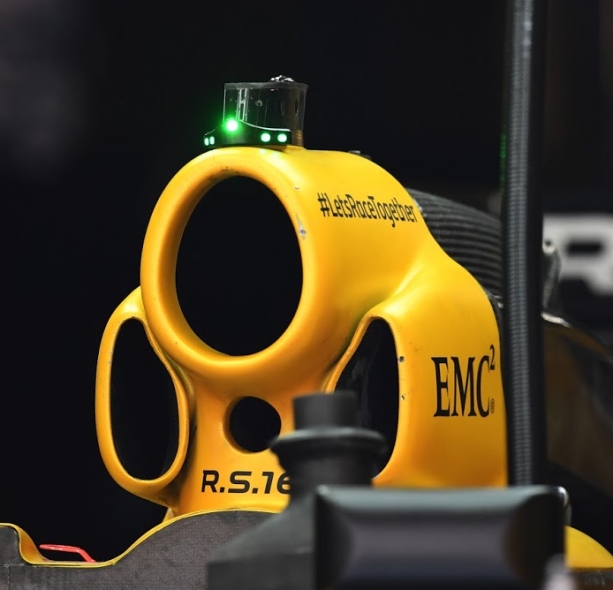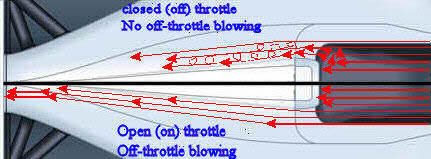Formula 1 Engine Air Intake - Airbox
 |
 |
Engine Air Intake - Airbox on Ferrari and Renault Formula 1 cars |
|
Lotus 72, is one of the most iconic Formula One cars of all time and its success and longevity in the sport are testament to its brilliant design. Among the most revolutionary cars to come out of Hethel's factory gates, some of the concepts behind the Colin Chapman- and Maurice Philippe-designed car were at least two years ahead of their time in 1970. Its side-mounted radiators and overhead airbox provided styling cues and engineering solutions that are still in use on modern F1 cars and its in-board brakes were just one example of Lotus's drive to reduce unsprung weight. After some initial teething problems it proved to be sensationally quick, and in the hands of some of the era's best drivers it won races in four of the six years it competed.
Matra introduced the trend to use very high airboxes. 1976 new ‘low airbox’ regulations introduced by the FIA and defined maximum airbox height at 85cm above the lowest sprung part of the car, but next year airbox height was redefined at 95cm above the ground.
 |
The Renault RS16's airbox is one of the largest in the 2016 field but, it is not the first time we have seen teams use this area and the roll hoop in different ways to achieve both structural and aerodynamic goals. While structural integrity is clearly paramount, as the roll hoop provides the driver with protection in the case of an accident, it is the aerodynamic advantage that can be delivered that is of the utmost importance. The new roll-hoop rules, allied to some experimenting at the time with F-ducts, led to teams exploring other areas before the switch to the hybrid V6 turbocharged power units in 2014 brought this area of the car sharply back into focus. The increased need to supply air to not only the turbo's compressor but also a vast array of radiators and air-to-air coolers meant it was important again. |
The engine air intake on Formula 1 car is positioned behind and above the driver's head to capture high-pressure, relatively undisturbed air. Inside the air intake is an expansion chamber (diffuser) that slows the air down and thus increases its pressure ready for its passage into the engine inlet manifold. The air intake is positioned away from sources of heat, such as the track and radiators, to minimize the air temperature. The intake faces the direction of travel to take advantage of a small ram effect the car induces as it moves forward through the air. But contrary to popular belief though, air is not pushed into this inlet, but the engine is sucking air in, reducing the drag penalty a normal cooling inlet would generate.
To know more about dynamics of air intake, check airbox article.
A couple of weeks ago I find an excellent article on Gordon McCabe blog explaining one phenomenon regarding Formula 1 airbox and Airbox air spillage. Link on this article you can find here. Picture is my small add.
Monday, October 31, 2011
 |
Just to make it clear for as, normal people. Under full throttle (lover part of the image), all air approaching airbox is sucked inside, trough engine and out trough exhaust. Same happened with hot or cold blowing. Engine pumps all air in. So, no air spillage around airbox. |
A couple of weeks ago, the FIA issued a Technical Directive to the Formula One teams, announcing that off-throttle blowing of the exhausts will be severely curtailed in 2012 by engine mapping restrictions.
In combination with stringent requirements on the position and angle of the exhaust exits, this is intended to minimise the exploitation of exhaust flow for aerodynamic purposes. It will, however, have a secondary consequence. As Gary Anderson recently explained, off-throttle exhaust flow also serves to reduce spillage from the airbox:
"In the past when the driver closed the throttle to slow for a corner, the airbox spillage became a lot worse. If the airflow attachment on the sides of the engine cover was not good, the performance of the rear wing would be compromised – not something the driver wants under braking or on corner entry.
"Step forward the blown diffuser. Hot or cold blowing allows the engine to work like an air pump, moving this airflow through (Airbox) and out of the exhausts. This reduces the potential turbulent airflow creating negative performance on the rear wing.
If off-throttle blowing of the exhausts is genuinely to be prohibited next year by means of engine mapping restrictions, this will presumably re-create the problem of airflow spilling out of the airbox when the driver lifts off the throttle on turn-in to a corner.
So here's an idea: Why not introduce a fluidic switch which, under certain circumstances, re-routes the airbox airflow through the chassis to the lower leading edge of the sidepods? This could have the joint benefit of boosting the velocity of the underbody flow, and improving airflow to the rear wing, just at the time when the driver most needs it, when the car is in pitch under braking and turn-in.






